Undercut Rocks / Ice
Undercut Rocks
Undercuts can be very dangerous as we will discuss in this article. Undercut rock formations are often quite irregular and may capture river debris like trees, branches, and manmade objects. Either way if you are in your boat or out of your boat, passing through an undercut rock is a crap shoot. Seldom can you see under the water surface and what you don't see can be very deadly indeed. Since undercuts are typically in rapids the force of water can be really strong as well. Undercut rocks are created where the water is most forceful like the outside of bends, waterfalls and high ledges, and sometimes in mid-current like the clam shell formation on Railroad Rapid on the New River Gorge.
Rescuing a paddler trapped in an undercut is very challenging as well. If you are lucky, you can get a rope to the victim while they are still upright. Even in those situations, you will often need to pull them back out against the same fast moving water they swept them there in the first place. Sometimes vertical rescue techniques are required and they take considerable time to safely set up.
The best way to avoid these hazards is to research your planned run in guide books and the AW River Database. Another good source is asking paddlers that have been down this run before. Many undercuts provide some clues if you scout from shore, walk to the end of the rapid, and look back upstream. If you have a large boulder and water isn't pillowing on the upstream side as well as a very weak eddy on the downstream side - stay away! This is a tell tale undercut formation. There isn't any water pressure forming the pillow because the water is leaking out from underneath.
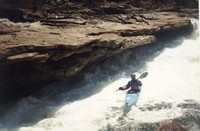 When running streams that have a sharp rock wall bend, angle your boat away from the wall. Water over time will undercut the rock wall, See example on the right. Once again if the wall is undercut, water is less likely to rise against the wall since it can escape underneath.
When running streams that have a sharp rock wall bend, angle your boat away from the wall. Water over time will undercut the rock wall, See example on the right. Once again if the wall is undercut, water is less likely to rise against the wall since it can escape underneath.
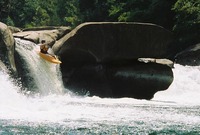 Waterfalls often form a double boil line at their curtain. The backside of the curtain gets carved away overtime forming an undercut. Notice how this waterfall is carved out on the kayakers right side. Rescues from this position are also quite tricky since it is hard to get a rope to the victim.
Waterfalls often form a double boil line at their curtain. The backside of the curtain gets carved away overtime forming an undercut. Notice how this waterfall is carved out on the kayakers right side. Rescues from this position are also quite tricky since it is hard to get a rope to the victim.
We will demonstrate a very deceptive undercut rock at the bottom of the Z Channel rapid using a throw rope.
Ice
Ice can form another type of undercut in the form of an ice shelf. Natural rivers rise and fall all the time. This can form air pockets underneath the ice shelf. Now add some fast current and you have the making of a mega-strainer. If you get swept underneath, you will find it very difficult to break your way through the ice ceiling. Large ice flows also act like big battering rams. Imagine having an ice sheet smack your rib cage. You also need to consider that we often paddle in remote locations and getting help in time isn't very likely. Winter paddling can be a great deal of fun but I stay off streams with lots of ice - it just isn't worth the risk. Here is an excellent video on the dangers of ice and rescue options: Dangers of Ice
Dams / Flow Diversion Structures / Pipelines
Introduction
Most of the hazards to be discussed in this article are manmade. As a general rule, I highly recommend portaging around man made obstructions. Most of these are made with concrete (not so bad) and reinforcement bar (very bad). They tend to break down over time exposing dangerous steel spikes. Although the plastic in our modern boats is quite strong, it is no match for a sharp steel rod which can puncture any boat instantaneously. Another problem with dams and pipelines is their perfectly uniform and smooth construction. This leads to holes with a very large backwash and no good way to escape.
Dams
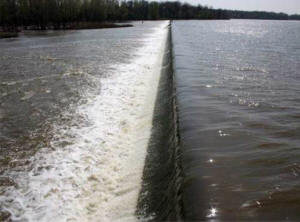 Dams can be manmade or natural. Of particular concern are low head dams also known as "The Drowning Machine). Manmade structures may also contain exposed rebar which can easily puncture plastic boats. Take great care whenever running manmade structures. This feature is so important to recognize I suggest you watch the following video: Low Head Dams. We will show you an example of a low head dam at Brookmont on the second day of our class.
Dams can be manmade or natural. Of particular concern are low head dams also known as "The Drowning Machine). Manmade structures may also contain exposed rebar which can easily puncture plastic boats. Take great care whenever running manmade structures. This feature is so important to recognize I suggest you watch the following video: Low Head Dams. We will show you an example of a low head dam at Brookmont on the second day of our class.
Flow Diversion Structures
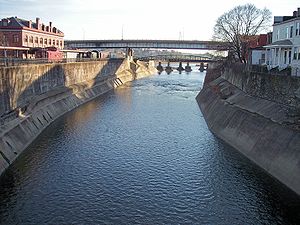 Many towns construct sluiceways to channelize water so it doesn't flood nearby neighborhoods. Notice the picture on the right, looks pretty harmless. Now imagine what it would look like with a lot more water. If you flip and swim, how in the world can you recover? The smooth sidewalls tend to make the water flow very fast as well so even if you did find something to hang on to, you will tire very quickly. Eventually the concrete structure comes to an end. The end is typically perfectly uniform and a real death trap of a hole. As tempting as this feature looks, stay away from these hazards and stick with the natural streams. One other this to consider, in many towns there are laws against entering these flood control sluices. Many people have drowned in them and rescues are very dangerous for the local fire departments.
Many towns construct sluiceways to channelize water so it doesn't flood nearby neighborhoods. Notice the picture on the right, looks pretty harmless. Now imagine what it would look like with a lot more water. If you flip and swim, how in the world can you recover? The smooth sidewalls tend to make the water flow very fast as well so even if you did find something to hang on to, you will tire very quickly. Eventually the concrete structure comes to an end. The end is typically perfectly uniform and a real death trap of a hole. As tempting as this feature looks, stay away from these hazards and stick with the natural streams. One other this to consider, in many towns there are laws against entering these flood control sluices. Many people have drowned in them and rescues are very dangerous for the local fire departments.
Pipelines
 Pipelines can act very similar to a manmade dam. They are essentially uniform with no breaks and at the right water level, they form holes that are very difficult to escape from. These need to be carefully scouted prior to running. Another worry about running a pipeline is the danger of undercuts. Since they are round, water can work its way underneath and create a dangerous entrapment possibility. Pipelines also need to be secured along their route which may leave areas where a boat or person can be snagged. Look before you leap.
Pipelines can act very similar to a manmade dam. They are essentially uniform with no breaks and at the right water level, they form holes that are very difficult to escape from. These need to be carefully scouted prior to running. Another worry about running a pipeline is the danger of undercuts. Since they are round, water can work its way underneath and create a dangerous entrapment possibility. Pipelines also need to be secured along their route which may leave areas where a boat or person can be snagged. Look before you leap.
Other Hazards
Introduction
Kayaking is an outdoor sport. As such, we need to be aware of various risks that are common on river trips. As always, it is a good idea to check out the weather report before the trip. Are they calling for severe thunderstorms and/or flooding. If so, that gauge reading you grabbed off of American Whitewater may change a great deal while you are on the river. Many paddlers have had to walk off rivers when the level rose abruptly and unexpectedly.
Besides the typical water related hazards, we may also encounter snakes, bugs, lightning, slippery rocks, etc. All of the hazards are quite manageable but you need to be aware of them to avoid problems.
Thunderstorms
Speaking of thunderstorms, FEMA has a pretty good description of the dangers and how to protect yourself: Thunderstorm Precautions. When boating, it is a wise precaution to get off the river and let the storm pass (it usually doesn't take too long). If you have something that resembles a shelter like a solid overhang, take advantage of that feature.
Flooding
Floods can be serious business as well. Water is powerful and should always be respected. Floods can be dangerous as they often uproot trees, weave their way through trees and bushes above the normal river banks, and often create dangerous pour over holes. Why bother with big streams that are in severe flood stage? You can often catch smaller streams (creeks) that are not in flood stage that are a great deal more fun.
Snakes
The most common poisonous snake in our region of the country is the Copperhead Snake. Here is a great article on this snake: Copperhead Snake. Cottonmouth or Water Moccasin Snake isn't as common as Copperheads but we have those as well: Cottonmouth Snake.
Poison Ivy
Poison Ivy is a common site on some rivers, especially at the takeout of the Shenandoah Staircase. Here is a great site to help you identify this pesky plant: Poison Ivy. If you come in contact with this plant, wash immediately and preferably with soap.
Hypothermia & Hyperthermia
I describe hypothermia and hyperthermia in a separate document: Hypothermia. The best precaution is drink plenty of fluids and dress appropriately.
Daylight
Running out of daylight can lead to serious complications. A few years ago several expert boaters put on late for a run down Moores Run into Otter Creek in West Virginia. They had several challenges along the way including boat pins, one walking out (smart move), getting separated, a bad facial injury, and getting stuck in the woods overnight in Winter weather without proper gear. They cost the local fire company a great deal of resources and soured local relationships pretty severely. Please learn from their mistakes (and they had plenty).
Wind
Excessive wind on large bodies of water like the Bay or large lakes can be dangerous as well. It is typically more an annoyance while running whitewater.
Ice
Ice is serious business. In general, stay off rivers that have a lot of ice on them. Ice can break off debris and form a really nasty and difficult to escape strainer.
Bees
Bees and Yellow jackets can be especially bad news for persons that are allergic to them. If you are allergic please let your trip leader know of your condition and by all means, carry your medicines in a dry bag. The same goes for any special medical issues like diabetes for example.
Cold Water
Cold water can be deadly for the unprepared. We often boat in water under 60° in temperature. In water between 40° and 50°, you have 30 - 60 minutes before you become unconscious. This might sound like a fairly decent amount of time on whitewater where you can quickly swim to shore. In large bodies of water, you can't swim to safety that fast. In whitewater we also have to consider entrapment possibilities. It takes time to setup an entrapment rescue. If you become unconscious, you can't help in your rescue and your face is likely to fall down in the water where you are likely to drown.
The best way to avoid this scenario is to dress appropriately. Many boaters paddle in cold weather with a dry top and not much below their waist. They feel warm since the boat provides significant insulating air. If they swim, they quickly lose body heat. In addition, they are useless for assisting in many rescues. Dress in layers that can be added or subtracted. Pack a hood or skull cap just in case. The hood doesn't take up much space and is amazing at providing quick warmth. The following article is excellent: Cold Water Survival. If you haven't done so, you should review the hypothermia article as well: Hypothermia & Hyperthermia.
Holes / Hydraulics
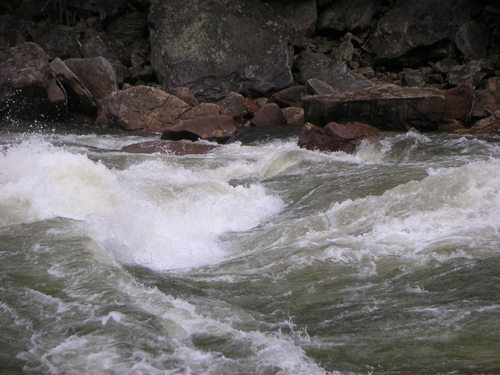 Holes (AKA: Souse Holes, Hydraulics) are caused by a depression in the river bed like water flowing over a boulder. Water cascades over the boulder (or ledge) forcefully downstream and water from downstream flows back upstream to fill in the depression. We often refer to holes as Smiles or Frowns. If the ends are out flowing downstream (Frown), you can exit the hole on either end. If the ends are facing upstream (Smile), exiting the hole isn't as easy. Upstream ended holes typically have a jet stream underwater that you can catch with your paddle or body to forcefully pull you down and out. A perfectly uniform hole - straight across like one formed by a dam can be very difficult to escape and often requires assistance. Smaller holes are often used like eddies by advanced paddlers. Play boaters (and squirt boaters) love holes as this feature enables the many tricks they like to perform. Notice the picture of Big Nasty on the Cheat River.
Holes (AKA: Souse Holes, Hydraulics) are caused by a depression in the river bed like water flowing over a boulder. Water cascades over the boulder (or ledge) forcefully downstream and water from downstream flows back upstream to fill in the depression. We often refer to holes as Smiles or Frowns. If the ends are out flowing downstream (Frown), you can exit the hole on either end. If the ends are facing upstream (Smile), exiting the hole isn't as easy. Upstream ended holes typically have a jet stream underwater that you can catch with your paddle or body to forcefully pull you down and out. A perfectly uniform hole - straight across like one formed by a dam can be very difficult to escape and often requires assistance. Smaller holes are often used like eddies by advanced paddlers. Play boaters (and squirt boaters) love holes as this feature enables the many tricks they like to perform. Notice the picture of Big Nasty on the Cheat River.
Play boaters absolutely love holes. This feature is where they can perform most of their tricks. Anyone venturing into class IV whitewater needs to be very comfortable surfing holes (just like class III boaters need solid boat reading skills, eddy turns, and ferry skills). The following video is excellent at describing basic hole surfing technique: Basic Hole Surfing Technique.
One type of hole we ALWAYS stay away from are those created by low head dams. These manmade structures create a perfectly uniform hole that you can't escape from. The backwash is often many yards downstream and very powerful - even motor boats are helpless once caught in the backwash. The following video is well worth watching to understand why these types of dams are so dangerous: Low Head Dam Video.
